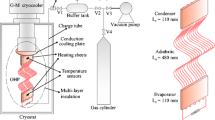Abstract
Next generation space infrared sensor and detector have pressing requirement for cryogenic heat transport technology in the temperature range of 30–40 K. Cryogenic loop heat pipe (CLHP) has excellent thermal performance and particular characteristics such as high flexibility transport lines and no moving parts, thus it is regarded as an ideal thermal control solution. A neon CLHP referring to infrared point-to-point heat transfer element in future space application has been designed and experimented. And it could realize supercritical startup successfully. Experimental results show that the supercritical startup were realized successfully at cases of 1.5 W secondary evaporator power, but the startup was failed when 0.5 and 1 W heat load applied to secondary evaporator. The maximum heat transport capability of primary evaporator is between 4.5 and 5 W with proper auxiliary heat load. Before startup, even the heat sink temperature decreased to 35 K, the primary evaporator can still maintain at almost 290 K; and the primary evaporator temperature increased at once when the powers were cut off, which indicated the CLHP has a perfect function of thermal switch. The CLHP could adapt to sudden changes of the primary evaporator power, and reach a new steady-state quickly. Besides, some failure phenomena were observed during the test, which indicated that proper secondary evaporator power and heat sink temperature play important roles on the normal operation.
















Similar content being viewed by others
Abbreviations
- T :
-
Absolute temperature (K)
- L :
-
Length (mm)
- P sys :
-
Pressure of system (MPa)
- Q se :
-
Auxiliary heat load (W)
- Q pe :
-
Primary heat load (W)
- T heat sink :
-
Temperature of heat sink (K)
- CC2:
-
Secondary compensation chamber
- LL2:
-
Secondary loop line
- CLHP:
-
Cryogenic loop heat pipe
- EV2-o:
-
Outlet of the secondary evaporator
- Con-o:
-
Outlet of the primary condenser
- EV1:
-
Primary evaporator
- EV1-o:
-
Outlet of the primary evaporator
- EV2:
-
Secondary evaporator
References
Bugby D, Marland B, Stouffer C et al (2004) Development of advanced tools for cryogenic integration. Adv Cryog Eng Trans Cryog Eng Conf 49:1914–1922
Pereira H, Haug F, Silva P et al (2010) Cryogenic loop heat pipes for the cooling of small particle detectors at CERN. Adv Cryog Eng Trans Cryog Eng Conf 55:1039–1046
Khrustalev D (2002) Test data for a cryogenic loop heat pipe operating in the temperature range from 65 K to 140 K. In: Presentation at the international two-phase thermal control technology workshop, Mitcheville, MD, 24–26 Sept 2002
Zhao Y, Yan T, Liang J (2011) Experimental study on a cryogenic loop heat pipe with high heat capacity. Int J Heat Mass Transf 54:3304–3308
Mo Q, Liang J (2006) A novel design and experimental study of a cryogenic loop heat pipe with high heat transfer capability. Int J Heat Mass Transf 49:770–776
Mo Q, Liang J, Cai J (2007) Investigation of the effects of three key parameters on the heat transfer capability of a CLHP. Cryogenics 47:262–266
Hoang TT, O’Connell TA, Ku J et al (2005) Performance demonstration of a hydrogen advanced loop heat pipe for 20–30 K cryocooling of far infrared sensors. Proc SPIE 5904:590410
Bai L, Lin G, Zhang H et al (2012) Experimental study of a nitrogen-charged cryogenic loop heat pipe. Cryogenics 52:557–563
Mo Q, Liang J (2006) Operational performance of a cryogenic loop heat pipe with insufficient working fluid inventory. Int J Refrig 29:519–527
Du C, Bai L, Lin G et al (2013) Determination of charged pressure of working fluid and its effect on the operation of a miniature CLHP. Int J Heat Mass Transf 63:454–462
Yan T, Zhao Y, Liang J et al (2013) Investigation on optimal working fluid inventory of a cryogenic loop heat pipe. Int J Heat Mass Transf 66:334–337
Guo Y, Lin G, Bai L et al (2016) Experimental study on the supercritical startup of cryogenic loop heat pipes with redundancy design. Energy Convers Manag 118:353–363
Hoang TT, O’Connell TA (2005) Performance demonstration of flexible advanced loop heat pipe for across-gimbal cryocooling. In: AIAA paper, No. 2005-5590
Bugby D, Marland B, Stouffer C et al (2003) Across-gimbal and miniaturized cryogenic loop heat pipes. In: Space technology and applications international forum-STAIF, pp 218–226
Hoang TT, O’Connell TA, Ku J et al (2003) Large area cryocooling for far infrared telescopes. Proc SPIE 5172:77–85
Bai L, Lin G, Peterson GP et al (2011) Modeling and analysis of supercritical startup of a cryogenic loop heat pipe. J Heat Transf V133:121501
Bai L, Lin G, Wen D (2010) Parametric analysis of steady-state operation of a CLHP. Appl Therm Eng 30:850–858
Bai L, Zhang L, Lin G et al (2015) Development of cryogenic loop heat pipes: a review and comparative analysis. Appl Therm Eng 89:180–191
Guo Y, Lin G, He J et al (2017) Experimental study on the supercritical startup and heat transport capability of a neon charged cryogenic loop heat pipe. Energy Convers Manag 134:178–187
Acknowledgements
Financial grants from the National Natural Science Foundation of China (NSFC Grant Nos. 51406009 and 51576010) are gratefully acknowledged.
Author information
Authors and Affiliations
Corresponding author
Ethics declarations
Conflict of interest
On behalf of all authors, the corresponding author states that there is no conflict of interest.
Rights and permissions
About this article
Cite this article
He, J., Guo, Y., Zhang, H. et al. Design and experimental investigation of a neon cryogenic loop heat pipe. Heat Mass Transfer 53, 3229–3239 (2017). https://doi.org/10.1007/s00231-017-2005-8
Received:
Accepted:
Published:
Issue Date:
DOI: https://doi.org/10.1007/s00231-017-2005-8




